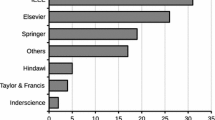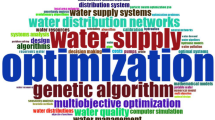Abstract
The Muskingum model continues to be a popular procedure for river flood routing. An important aspect in nonlinear Muskingum models is the calibration of the model parameters. The current study presents the application of commonly available spreadsheet software, Microsoft Excel 2010, for the purpose of estimating the parameters of nonlinear Muskingum routing models. Main advantage of this approach is that it can calibrate the parameters using two different ways without knowing the exact details of optimization techniques. These procedures consist of (1) Generalized Reduced Gradient (GRG) solver and (2) evolutionary solver. The first one needs the initial values assumption for the parameter estimation while the latter requires the determination of the algorithm parameters. The results of the simulation of an example that is a benchmark problem for parameter estimation of the nonlinear Muskingum models indicate that Excel solver is a promising way to reduce problems of the parameter estimation of the nonlinear Muskingum routing models. Furthermore, the results indicate that the efficiency of Excel solver for the parameter estimation of the models can be increased, if both GRG and evolutionary solvers are used together.
Similar content being viewed by others
References
Akbari, G. H. and Barati, R. (2012). “Comprehensive analysis of flooding in unmanaged catchments.” Proceedings of the Institution of Civil Engineers-Water Management, p. 165.
Akbari, G., H. Nezhad, A. H., and Barati, R. (2012). “Developing a model for analysis of uncertainties in prediction of floods.” Journal of Advanced Research, Vol. 3, No. 1, pp. 73–79.
Al-Humoud, J. M. and Esen, I. I. (2006). “Approximate methods for the estimation of Muskingum flood routing parameters.” Water Resources Management, Vol. 20, No. 6, pp. 979–990.
ASCE Task Committee on Definition of Criteria for Evaluation of Watershed Models of the Watershed Management Committee, Irrigation and Drainage Division. (1993). “Criteria for evaluation of watershed models.” Journal of Irrigation and Drainage Engineering, ASCE, Vol. 119, No. 3, pp. 429–442.
Barati, R. (2011). “Discussion of Parameter estimation for nonlinear Muskingum model based on immune clonal selection algorithm.” Journal of Hydrologic Engineering, ASCE, Vol. 16, No. 4, pp. 391–393.
Bhattacharjya, R. K. (2011). “Solving groundwater flow inverse problem using spreadsheet solver.” Journal of Hydrologic Engineering, ASCE, Vol. 16, No. 5, pp. 472–477.
Choudhury, P. (2007). “Multiple inows muskingum routing model” Journal of Hydrologic Engineering, ASCE, Vol. 12, No. 5, pp. 473–481.
Choudhury, P., Shrivastava, R. K., and Narulkar, S. M. (2002). “Flood routing in river networks using equivalent muskingum inow.” Journal of Hydrologic Engineering, ASCE, Vol. 7, No. 6, pp. 413–419.
Chow, V. T. (1959). “Open channel hydraulics.” McGraw-Hill, New York, p. 680.
Chu, H. J. (2009). “The Muskingum flood routing model using a neurofuzzy approach.” KSCE Journal of Civil Engineering, KSCE, Vol. 13, No. 5, pp. 371–376.
Chu, H. J. and Chang, L. C. (2009). “Applying particle swarm optimization to parameter estimation of the nonlinear Muskingum model.” Journal of Hydrologic Engineering, ASCE, Vol. 14, No. 9, pp. 1024–1027.
Das, A. (2004). “Parameter estimation for muskingum models.” Journal of Irrigation and Drainage Engineering, ASCE, Vol. 130, No. 2, pp. 140–147.
Das, A. (2007). “Chance-constrained optimization-based parameter estimation for Muskingum models.” Journal of Irrigation and Drainage Engineering, ASCE, Vol. 133, No. 5, pp. 487–494.
Fontane, D. (2001). “Multi-objective simulation and optimization of reservoir operation using Excel.” Proceeding of the Second Federal Interagency Hydrologic Modeling Conference, Las Vegas, NV, USA.
Geem, Z. W. (2006). “Parameter estimation for the nonlinear Muskingum model using the BFGS technique.” Journal of Irrigation and Drainage Engineering, ASCE, Vol. 132, No. 5, pp. 474–478.
Gill, M. A. (1978). “Flood routing by Muskingum method.” Journal of hydrology, Vol. 36, No. 3–4, pp. 353–363.
Grabow G. L. and McCornick P. G. (2007). “Planning for water allocation and water quality using a spreadsheet-based model.” Journal of Water Resources Planning and Management, ASCE, Vol. 133, No. 6, pp. 560–564.
Huddleston, D. H., Alarcon, V. J., and Chen, W. (2004). “Water distribution network analysis using Excel.” Journal of Hydraulic Engineering, ASCE, Vol. 130, No. 10, pp. 1033–1035.
Kim, J. H., Geem, Z. W., and Kim, E. S. (2001). “Parameter estimation of the nonlinear Muskingum model using harmony search.” Journal of the American Water Resources Association, Vol. 37, No. 5, pp. 1131–1138.
Lasdon, L. S. and Smith, S. (1992). “Solving sparse nonlinear programs using GRG.” ORSA Journal on Computing, Vol. 4, No. 1, pp. 2–15.
Lasdon, L. S., Waren, A. D., Jain, A., and Ratner, M. (1978). “Design and testing of a generalized reduced gradient code for nonlinear programming.” ACM Transactions on Mathematical Software, Vol. 4, No. 1, pp. 34–50.
Lee, J. S. (2003). “Uncertainties in the predicted number of life loss due to the dam breach floods.” KSCE Journal of Civil Engineering, KSCE, Vol. 7, No. 1, pp. 81–91.
Lee, J. S. and Noh, J. W. (2003). “The impacts of uncertainty in the predicted dam breach floods on economic damage estimation” KSCE Journal of Civil Engineering, KSCE, Vol. 7, No. 3, pp. 343–350.
Luo, J. and Xie, J. (2010). “Parameter estimation for nonlinear Muskingum model based on immune clonal selection algorithm.” Journal of Hydrologic Engineering, ASCE, Vol. 15, No. 10, pp. 844–851.
McCuen, R. H., Knight, Z., and Cutter, A. G. (2006). “Evaluation of the Nash-Sutcliffe efficiency index.” Journal of Hydrologic Engineering, ASCE, Vol. 11, No. 6, pp. 597–602.
Mohan, S. (1997). “Parameter estimation of nonlinear Muskingum models using genetic algorithm.” Journal of Hydraulic Engineering, ASCE, Vol. 123, No. 2, pp. 137–142.
Murtagh, B. A. and Saunders, M. A. (1978). “Large-scale linearly constrained optimization.” Mathematical Programming, Vol. 14, No. 1, pp. 41–72.
Papamichail, D. and Georgiou, P. (1994). “Parameter estimation of linear and nonlinear Muskingum models for river flood routing.” Transactions on Ecology and the Environment, 7, WIT Press, http://www.Witpress.com, ISSN pp. 1743–3541.
Premium Solver Platform, User Guide. (2010). Frontline Systems, Inc., Notes downloaded from the site http://www.solver.com.
Toprak, Z. F. (2009) “Flow discharge modeling in open canals using a new fuzzy modeling technique (SMRGT).” CLEAN-Soil, Air, Water, Vol. 37, No. 9, pp. 742–752.
Toprak, Z. F. and Cigizoglu, H. K. (2008) “Predicting longitudinal dispersion coefficient in natural streams by artificial intelligence methods.” Hydrological Processes, Vol. 22, No. 20, pp. 4106–4129.
Toprak, Z. F., Eris, E., Agiralioglu, N., Cigizoglu, H. K., Yilmaz, L., Aksoy, H., Coskun, G., Andic, G., and Alganci, U. (2009) “Modeling monthly mean flow in a poorly gauged basin by fuzzy logic.” CLEAN-Soil, Air, Water, Vol. 37, No. 7, pp. 555–564.
Toprak, Z. F. and Savci, M. E. (2007). “Longitudinal dispersion coefficient modeling in natural channels using fuzzy logic.” CLEAN-Soil, Air, Water, Vol. 35, No. 6, pp. 626–637.
Tung, Y. K. (1985). “River flood routing by nonlinear Muskingum method.” Journal of Hydraulic Engineering, ASCE, Vol. 111, No. 12, pp. 1447–1460.
Wilson, E. M. (1974). Engineering hydrology, MacMillan, Hampshire, UK.
Wong, T. S. W. and Zhou, M. C. (2004). “Determination of critical and normal depths using excel.” Proceedings of World Water and Environmental Resources Congress, Saltlake City Utah, USA.
Yidana, S. M. and Ophori, D. (2008). “Groundwater resources management in the Afram plains area, Ghana.” KSEC Journal of Civil Engineering, KSCE, Vol. 12, No. 5, pp. 349–357.
Yoon, J. W., and Padmanabhan, G. (1993). “Parameter estimation of linear and nonlinear Muskingum models.” Journal of Water Resources Planning and Management, ASCE, Vol. 119, No. 5, pp. 600–610.
Author information
Authors and Affiliations
Corresponding author
Rights and permissions
About this article
Cite this article
Barati, R. Application of excel solver for parameter estimation of the nonlinear Muskingum models. KSCE J Civ Eng 17, 1139–1148 (2013). https://doi.org/10.1007/s12205-013-0037-2
Received:
Revised:
Accepted:
Published:
Issue Date:
DOI: https://doi.org/10.1007/s12205-013-0037-2




